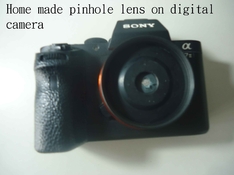How to eliminate vignetting in pinhole photos?
The diameter of the pinhole is approx 0.4mm, in aluminum foil.
The pinhole is approx 1.5~2mm from the camera's lens mount.
The size of the image is about that of 22~23mm wide angle.
The issue:
1.Vegnitting on both sides of the image.
2.Fade greysh tone on top and bottom side.
How to eliminate the vignetting, please?
Thanks.
Kuenp
The diameter of the pinhole is approx 0.4mm, in aluminum foil.
The pinhole is approx 1.5~2mm from the camera's lens mount.
The size of the image is about that of 22~23mm wide angle.
The issue:
1.Vegnitting on both sides of the image.
2.Fade greysh tone on top and bottom side.
How to eliminate the vignetting, please?
Thanks.
Kuenp



